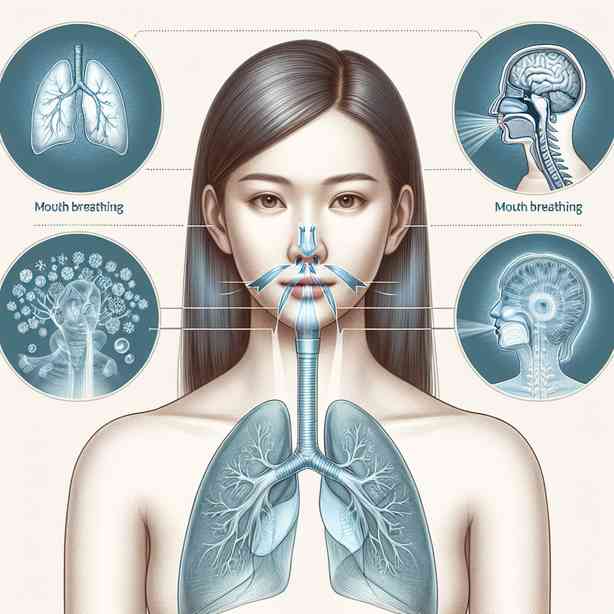
Mouth breathing is a behavior that many people engage in, often without realizing its implications for their health and overall well-being. Understanding the significance of mouth breathing is essential for everyone, as it can affect various aspects of physical health, mental well-being, and even social interactions. This comprehensive exploration will address the causes and effects of mouth breathing, how it differs from nasal breathing, its potential health risks, and the strategies for correcting this habit.
From a physiological perspective, humans are designed to breathe through their noses. The nose serves multiple functions that facilitate optimal breathing, including filtering, warming, and humidifying the air before it enters the lungs. When we breathe through our mouths, we bypass these essential processes, leading to various potential adverse effects. The anatomy of the nasal passages allows for efficient airflow and the exchange of gases, while mouth breathing can lead to dry mouth, dental issues, and other health complications.
One major concern associated with mouth breathing is its impact on oral health. The saliva in our mouths plays a critical role in maintaining oral hygiene. It helps wash away food particles and neutralizes acids produced by bacteria in the mouth. When breathing is predominantly through the mouth, saliva production decreases, leading to an increase in plaque buildup and a higher risk of cavities and gum disease. Furthermore, dry mouth can contribute to bad breath, which may affect social interactions and self-esteem.
Another significant issue arising from mouth breathing is its effect on facial development, particularly in children. Research indicates that mouth breathing can alter the growth of the maxilla and mandible, leading to improper alignment of the teeth, facial asymmetry, and even issues with speech development. This creates a cycle where dental problems fuel more mouth breathing, perpetuating the underlying issues and impacting a child’s confidence and quality of life.
In addition to oral health and facial development, mouth breathing can profoundly affect overall respiratory health. The act of breathing through the mouth allows for less filtration of airborne particles and allergens, potentially leading to increased respiratory infections, asthma, and allergies. Nasal breathing, on the other hand, helps filter these contaminants, reducing the risk of respiratory issues while also promoting better oxygenation of the blood. This highlights the importance of using the nasal airways whenever possible for both adults and children.
Moreover, the physiological effects of mouth breathing extend beyond physical health. Disruption of natural breathing patterns has been linked to anxiety, depression, and sleep disturbances. Individuals who breathe through their mouths may experience increased stress levels as they may not be engaging in proper diaphragmatic breathing, which lowers heart rate and enhances relaxation. This further emphasizes the need to cultivate healthy breathing habits for psychological well-being.
Mouth breathing also affects sleep quality. It is often associated with sleep apnea, a condition characterized by intermittent cessation of breath during sleep. Sleep apnea can lead to fragmented sleep, daytime fatigue, and cognitive impairments. People who suffer from mouth breathing during sleep may not reach deeper sleep stages, which are crucial for physical rejuvenation and mental clarity. It is critical to address mouth breathing to improve both the quality of sleep and overall health.
Fortunately, there are various strategies to help mitigate mouth breathing and encourage the practice of nasal breathing. Identifying the underlying causes is essential. Allergies, nasal congestion, or structural abnormalities can lead to mouth breathing. Consulting healthcare professionals like dentists, orthodontists, or ENT specialists can provide valuable insights and possible treatments. Simple lifestyle changes, such as using saline nasal sprays, practicing good nasal hygiene, or seeking allergy treatments, can also be effective.
Encouraging children to breathe through their noses starts with leading by example. Engaging in activities that promote proper breathing, such as yoga or breathing exercises, can also be beneficial. These practices not only strengthen respiratory muscles but also enhance relaxation and mindfulness, leading to an overall improvement in life quality.
Creating a reminder system can also be effective for those who struggle with the habit of mouth breathing. Gentle reminders placed around the home, such as notes or visual cues, can help individuals become more conscious of their breathing patterns. This increased awareness can promote positive behavior changes over time.
In conclusion, mouth breathing is a commonly overlooked behavior that can have significant implications for health and well-being. From oral and respiratory health to psychological effects and sleep quality, the impact is vast and multifaceted. By understanding the importance of breathing through the nose, individuals can take proactive steps to improve their health, boost self-confidence, and enhance their overall quality of life. Through a combination of awareness, professional guidance, and lifestyle adjustments, it is possible to move toward healthier breathing patterns. Prioritizing nasal breathing can lead to a cascade of health benefits that contribute to a happier, healthier life. Embracing this fundamental aspect of our physiology is essential for achieving optimum wellness and vitality.


